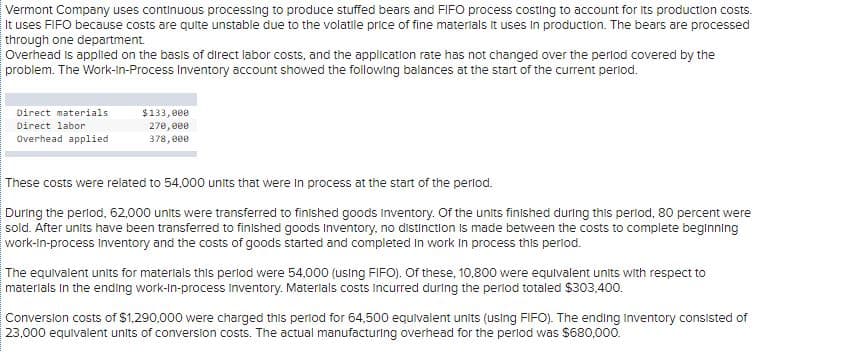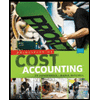Vermont Company uses continuous processing to produce stuffed bears and FIFO process costing to account for its production costs. It uses FIFO because costs are quite unstable due to the volatile price of fine materials it uses in production. The bears are processed through one department. Overhead is applied on the basis of direct labor costs, and the application rate has not changed over the perlod covered by the problem. The Work-in-Process Inventory account showed the following balances at the start of the current perlod. Direct materials $133, 000 Direct labor 270, ee0 Overhead applied 378, eee These costs were related to 54,000 units that were in process at the start of the perlod. During the perlod, 62,000 units were transferred to finished goods Inventory. Of the units finished during this period, 80 percent were sold. After units have been transferred to finished goods Inventory, no distinction is made between the costs to complete beginning work-in-process inventory and the costs of goods started and completed in work in process this period. The equivalent units for materials this perlod were 54,000 (using FIFO). Of these, 10,800 were equivalent units with respect to materials in the ending work-in-process inventory. Materials costs incurred during the perlod totaled $303,400. Converslon costs of S1.290,000 were charged this perfod for 64,500 equivalent units (using FIFO). The ending Inventory consisted of 23,000 equivalent units of converslon costs. The actual manufacturing overhead for the perlod was $680,000.
Vermont Company uses continuous processing to produce stuffed bears and FIFO process costing to account for its production costs. It uses FIFO because costs are quite unstable due to the volatile price of fine materials it uses in production. The bears are processed through one department. Overhead is applied on the basis of direct labor costs, and the application rate has not changed over the perlod covered by the problem. The Work-in-Process Inventory account showed the following balances at the start of the current perlod. Direct materials $133, 000 Direct labor 270, ee0 Overhead applied 378, eee These costs were related to 54,000 units that were in process at the start of the perlod. During the perlod, 62,000 units were transferred to finished goods Inventory. Of the units finished during this period, 80 percent were sold. After units have been transferred to finished goods Inventory, no distinction is made between the costs to complete beginning work-in-process inventory and the costs of goods started and completed in work in process this period. The equivalent units for materials this perlod were 54,000 (using FIFO). Of these, 10,800 were equivalent units with respect to materials in the ending work-in-process inventory. Materials costs incurred during the perlod totaled $303,400. Converslon costs of S1.290,000 were charged this perfod for 64,500 equivalent units (using FIFO). The ending Inventory consisted of 23,000 equivalent units of converslon costs. The actual manufacturing overhead for the perlod was $680,000.
Principles of Cost Accounting
17th Edition
ISBN:9781305087408
Author:Edward J. Vanderbeck, Maria R. Mitchell
Publisher:Edward J. Vanderbeck, Maria R. Mitchell
Chapter6: Process Cost Accounting—additional Procedures; Accounting For Joint Products And By-products
Section: Chapter Questions
Problem 8E: Sonoma Products Inc. manufactures a liquid product in one department. Due to the nature of the...
Related questions
Question
For this question I have to prepare T-accounts to show the flow of costs. (Any difference between actual and applied
In the given T-account each blue outlined box has a drop down menu with the given options:
- Conversion
- From beginning inventory
- From finished goods
- Materials
- Overapplied overhead
- To cost of goods sold
- Transferred in
- Transferred out
- Underapplied overhead

Transcribed Image Text:Work in Process
Finished Goods
Beg. bal.
Beg. bal.
Current work:
Transferred out:
From current work:
End. bal.
End, bal.
Cost of Goods Sold
Beg. bal.
End. bal.

Transcribed Image Text:Vermont Company uses continuous processing to produce stuffed bears and FIFO process costing to account for Its production costs.
It uses FIFO because costs are quite unstable due to the volatile price of fine materlals it uses in production. The bears are processed
through one department.
Overhead is applied on the basis of direct labor costs, and the application rate has not changed over the perlod covered by the
problem. The Work-In-Process Inventory account showed the following balances at the start of the current perlod.
Direct materials
$133,000
270, 000
378,000
Direct labor
Overhead applied
These costs were related to 54,000 units that were In process at the start of the perlod.
During the perlod, 62,000 units were transferred to finished goods inventory. Of the units finished during this period, 80 percent were
sold. After units have been transferred to finished goods Inventory, no distinction Is made between the costs to complete beginning
work-in-process inventory and the costs of goods started and completed in work in process this period.
The equivalent units for materials this perlod were 54,000 (using FIFO). Of these, 10,800 were equlvalent units with respect to
materials in the ending work-in-process inventory. Materlals costs incurred during the period totaled $303,400.
Conversion costs of $1,290,000 were charged this period for 64,500 equivalent units (using FIFO). The ending Inventory consisted of
23,000 equlvalent unlts of conversion costs. The actual manufacturing overhead for the perlod was $680,000.
Expert Solution
This question has been solved!
Explore an expertly crafted, step-by-step solution for a thorough understanding of key concepts.
This is a popular solution!
Trending now
This is a popular solution!
Step by step
Solved in 2 steps

Knowledge Booster
Learn more about
Need a deep-dive on the concept behind this application? Look no further. Learn more about this topic, accounting and related others by exploring similar questions and additional content below.Recommended textbooks for you

Principles of Cost Accounting
Accounting
ISBN:
9781305087408
Author:
Edward J. Vanderbeck, Maria R. Mitchell
Publisher:
Cengage Learning

Cornerstones of Cost Management (Cornerstones Ser…
Accounting
ISBN:
9781305970663
Author:
Don R. Hansen, Maryanne M. Mowen
Publisher:
Cengage Learning

Financial And Managerial Accounting
Accounting
ISBN:
9781337902663
Author:
WARREN, Carl S.
Publisher:
Cengage Learning,

Principles of Cost Accounting
Accounting
ISBN:
9781305087408
Author:
Edward J. Vanderbeck, Maria R. Mitchell
Publisher:
Cengage Learning

Cornerstones of Cost Management (Cornerstones Ser…
Accounting
ISBN:
9781305970663
Author:
Don R. Hansen, Maryanne M. Mowen
Publisher:
Cengage Learning

Financial And Managerial Accounting
Accounting
ISBN:
9781337902663
Author:
WARREN, Carl S.
Publisher:
Cengage Learning,

Managerial Accounting
Accounting
ISBN:
9781337912020
Author:
Carl Warren, Ph.d. Cma William B. Tayler
Publisher:
South-Western College Pub

Principles of Accounting Volume 2
Accounting
ISBN:
9781947172609
Author:
OpenStax
Publisher:
OpenStax College